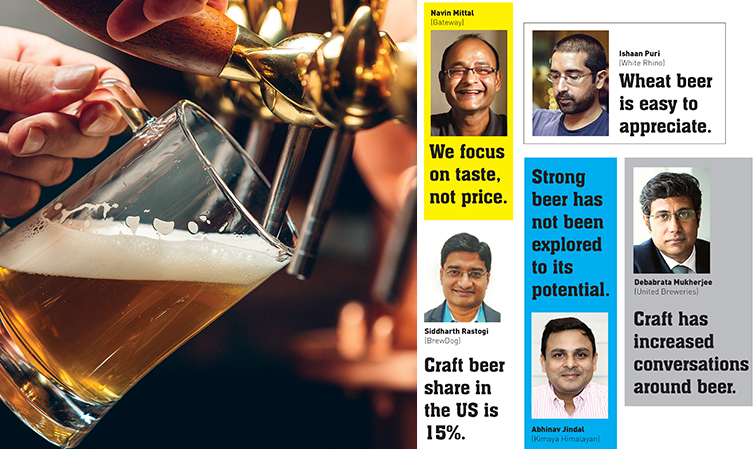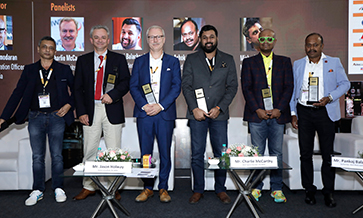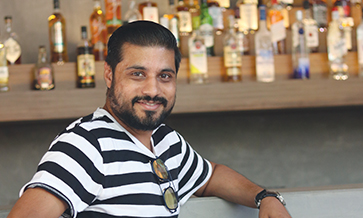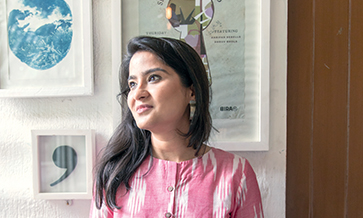Hidden under the debate of ‘craft’ versus ‘commercial’ are several untapped markets and growth opportunities. Vikram Achanta blows away the froth to taste the brew.
The beer industry in India, currently weighs in at upward of 350 million cases (2018-19), with an estimated cumulative annual growth rate in the high single digits between now and 2024.
The last few years have, however, seen it buffeted due to the impact of regulatory issues at the central and state levels – such as demonetisation and highway retail ban – but there should be no apparent reason to hold back its growth over the next few years. Some of the reasons for my optimism are:
- Per capita consumption of beer in India is only 2 litres;
- This compares to 37 litres for China and 42 litres in Vietnam;
- The beer industry is roughly equivalent in size (by volume) to the spirits industry;
- In most markets around the world, beer volumes are 3-4 times higher than those of spirits;
- More than 50% of India’s population is under the age of 25, and 65% under 35 years;
- This young population is extremely aspirational and choosy; and beer is seen as a “cool” drink to enjoy;
- 20 crore people are expected to attain the legal drinking age over the next 10 years.
‘Strong’ tradition
From the Indian consumer perspective beer is largely viewed through the lens of either ‘strong’ (6-8% ABV) or lager, with the bulk of the consumer base not necessarily distinguishing that the strong beer they are drinking is also a lager style beer.
Depending on whom you speak to, ‘strong’ beer accounts for up to 90% of total beer volumes, with brands like Kingfisher Strong, Carlsberg Elephant, Tuborg Strong, Budweiser Magnum, and Godfather, among others, ruling the roost.
The last 10 years, however, has seen a trend that bears asking the question: Are we going to see the pendulum swing significantly away from strong beer any time soon? Or, how is the landscape for the beer industry in India likely to change over the next few years? Some of these trends include:
In the past decade the number of states in India that permit brewpubs has approached double figures, and resulted in up to 200 brewpubs taking wing. Bengaluru, Gurugram and Hyderabad are the main epicentres of this movement – and that is no surprise, given the substantial catchment of corporate culture and a young workforce.
Apart from producing fresh beer, the range of experimentation in styles by several of these brewpubs has led to growing education of the urban Indian consumer.
Several of these brewpubs have gone on to expand their presence within their home state (Independence, Doolally and Effingut in Maharashtra) as well as across state borders (Toit Brewpub, with outlets in Bengaluru, Mumbai and Pune) and Arbor Brewing Co. (Bengaluru and Goa).
Some, like Arbor, have also gone on to introduce packaged beer under their own brand, with Bengaluru’s Toit and Windmills Craftworks also expected to follow suit shortly.
Craft connotations
Several Indian entrepreneurs, many from non-traditional backgrounds, have entered the beer business, and are producing what can be termed as craft beer in varied styles and packaging formats – kegs, cans and bottles – and with a focus on imaginative and creative branding.
As Navin Mittal, co-founder of Mumbai’s Gateway Brewing says, “We wanted to focus on taste. We are not interested in making the cheapest drink that will appeal to no one.”
Their models have differed, with some contract brewing overseas and importing, and others either contract brewing in India (Bira, White Owl) or setting up their own breweries (White Rhino, Goa Brewing).
Some, among them Bira and White Rhino, have even gone on to export their beer around the globe. Fancy a White Rhino IPA in London, or Bira 91 in New York? It’s possible!
Enter the giants – United Breweries, AB Inbev and Carlsberg, between them control 90% of the Indian beer market. They also have taken note of the shift in urban tastes by revamping their selection of locally brewed beer.
AB Inbev has set up a new unit called ‘7 Rivers Brewing Co.’, which has launched two local wheat beers, Veere and Machaa. UB’s Kingfisher recently launched a new brand extension under their popular Ultra label, the Kingfisher Ultra Wit.
We are now seeing beer companies enter the brewpub arena, with AB Inbev collaborating with Taj Hotels to open a chain of brewpubs. Bira 91 recently opened its first taproom in Bengaluru.
Rahul Singh, Founder and CEO of India’s largest beer pub chain, The Beer Café, was quoted recently in the Economic Times as saying, “Beer giants don’t want to be late in the game. They want to build their offering, erode the edge of micro-brewery territory and beat the competition with the vibe. They have the bandwidth of large-scale distribution, which will bring down the price point of craft beer for the consumer.”
Not just lager
Wheat beer as a style has caught the imagination of the Indian youth, largely due to its sweeter taste profile, and to a strong legacy linkage with Hoegaarden, which has given wheat beer a “premium” tag.
Ishaan Puri of White Rhino Brewing explains: “Wheat beers are very low in hop character (bitterness) and have a flavour profile for which one doesn’t really need to acquire a taste. The flavour tends to be neutral to mildly floral and citrusy. It is very easy to appreciate even for people who aren’t accustomed to European lagers, IPAs or Stouts.”
In fact, wheat is such an important category in India that international craft beer major, Brew Dog, has brewed Wild Card Wheat, a Hefeweizen style wheat beer specifically for the Indian market.
All of these are no doubt significant trends, especially when taken together. But are they enough to significantly increase the 10-15% share of light lager beer, as compared to craft beer volumes (1.5%) in India? “Unlikely,” say industry experts.
Many of them say that ‘strong’ beer is not necessarily a bad thing. Rakshat Chopra, beer industry veteran and alcobev industry consultant says, “In developed markets like the US and UK, distinct preferences have emerged for styles of beer such as say West Coast IPA or New England IPA. In a market like India the customer is not that evolved. But strong beer is a necessary evil, as it paves the way for an entry into the beer category for many.”
Growth path
The scope for playing a lead role in establishing consumer preferences and tastes is reason enough for the numerous craft/ variety beer brands jostling for space.
Siddharth Rastogi, BrewDog India’s Country Manager notes: “All major craft beer markets around the world have gone through similar evolution cycles, from an industrial beer market with commercial lagers to a craft beer market. In developed markets like the US about 15% market share has been taken by craft beer.”
Strong beer is always likely going to be the primary entry point into the beer category for most Indians. However, as we have seen in other beverage categories, as incomes and aspirations rise, there is a shift to more premium beers.
In India it will typically translate to premium light lagers, or other styles of beer, whether on tap or available in retail.
Debabrata Mukherjee, CMO of United Breweries, says there is headroom for growth in all beer categories in India, given the expected increase in the overall size of the market.
He says the crucial role that craft beer has played so far is that it has led to an “increased level of conversations around beer, which augurs well for the overall category”.
Survival instinct
The craft/ variety beer sector has already seen a shakeout in Chandigarh and Gurugram, but this has been for the best. Brewpubs with a focus on ‘True to the Brew’ look like they will be around for the long haul, but still with a largely local impact.
It is the packaged beer companies – those selling in cans or bottles – that have a greater challenge when it comes to survival, because selling beer in India requires deep pockets. At the bottle/can level, some of these brands may be profitable due to their premium pricing, but perhaps not at the aggregate level.
Abhinav Jindal, Founder and CEO of Kimaya Himalayan Beverages says, “It’s not the financial requirement that is the pain point, but the regulatory framework. That’s where small entrants should not be treated on par with larger companies in terms of the fees and duties.”
‘Strong craft beer’ is not an oxymoron, and is one of the more interesting ways in which the beer market and related categories are evolving in India. A lot of brand owners are realising that there is more to strong beer than just the ABV.
If they can also add to the mix, flavour, branding and product quality, then perhaps they have an even better winning proposition. Abhinav of Kimaya, which has launched Bee Young, its crafted strong beer says, “This is a category which has not been explored to the best of its potential.”
Larger bouquet
Let’s start first with related categories, which have seen some interesting product introductions. Bro Code, launched by Indo Spirit some time back, has registered extremely healthy volumes. But it is not a beer!
Sameer Mahandru of Indo Spirit says his company recognised that one of the USPs of beer was the convenience of consumption, and therefore decided to “create a sparkling wine in a beer-similar packaging format”. At a 15% ABV Bro Code sure is a winning proposition in the wine industry and has also emerged as a competitor for strong beer brands.
Another example is that of cider, where we have seen the recent launch of Siqera, a craft cider from Haryana, launched in apple and mango variants, at an ABV of 9%. Siqera is made by an expert brewmaster and the blend’s taste certainly reflects that.
Then we have the examples of Medusa, which has distinguished itself by its packaging; and the recently launched Spike from White Owl. Javed Murad, Founder of White Owl says, “Like all our brews, Spike is a flavour-forward, light-bodied and low-bitterness beer.”
Bengaluru’s Geist, a craft brewery known for the quality of its brews, has seen considerable success in its recently launched James Blond, a Belgian blond ale at 7.8% ABV.
Legacy brands like Godfather also are upping their game. Prem Dewan of Devan’s Breweries tells me, “The Godfather of the ‘90s is a pale shadow of the Godfather of today.”
Debu Mukherjee of UB says that, as in spirits in beer too consumers will have a “repertoire of beers, with their consumption linked to their need state and occasion relevance.”
There appear to be no two opinions about the continued and rapid growth of the beer market in India, with the prospects of all categories and styles only bound to improve. The space for craft/ variety beer is expanding fast, with the urban consumer lapping these up.
In the ‘strong’ beer category, we are seeing brands attempting to create well-crafted brews. All in all, a heady mix is in store for beer lovers in India in the years to come. Hop-Hop Hurray!













